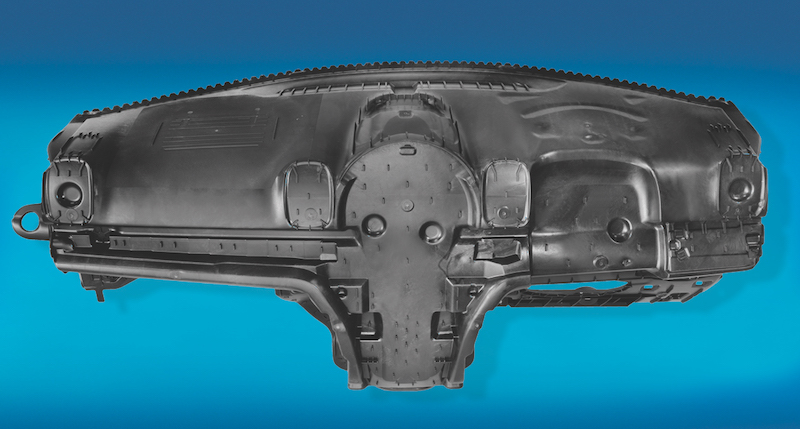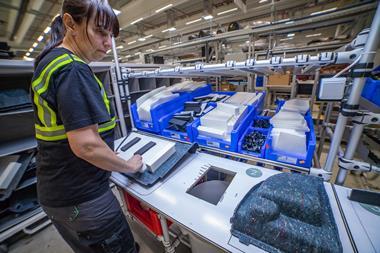Specialists in automotive interiors have long been at the sharp end of sustainability issue. Gareth Price looks at the controls and techniques that are helping IAC Group improve process control and lower energy consumption
 Ever since environmental impact became a hot topic for discussion and action within the automotive manufacturing industry, material use and process has been under scrutiny. At International Automotive Components Group (IAC), a tier one supplier of interior systems and components, routes are being investigated to move away from petroleum-based polymers in its core portfolio of instrument panels, cockpit systems, door, overhead and trim systems.
Ever since environmental impact became a hot topic for discussion and action within the automotive manufacturing industry, material use and process has been under scrutiny. At International Automotive Components Group (IAC), a tier one supplier of interior systems and components, routes are being investigated to move away from petroleum-based polymers in its core portfolio of instrument panels, cockpit systems, door, overhead and trim systems.
Mike Clowry, IAC’s vice president for advanced development and materials engineering tells AMS about the manufacturing processes that the company deploys to mesh sustainability with ingenuity and keeping premium OEM customers satisfied in the process.
Taking control IAC is several iterations into what it calls FastKast, a slush-skin process that it believes improves quality, reduces cycle times, and is environmentally friendly. The process was launched as a phase one a few years ago, the primary focus was on improved process control and on lower energy consumption. “Each iterative step is focused on lower energy consumption and tighter process control. And the beauty of it is they go together,” Clowry explains, “So, as we improve our energy consumption we inherently improve the process control because we have to have finer control over the temperature that we distribute across the nickel shell [tooling].”
To produce the slush skins typically seen on many instrument panels, the traditional method was to use air or oil slush – using hot air or hot oil to heat the tools that allowed the PVC to melt and start forming the skin. By definition, the tooling is complicated and energy hungry. Clowry says, “Just flooding the whole chamber with hot air to try and bring this now very heavy tool up to a certain temperature, or oil as the alternative, was all very energy inefficient. Our FastKast process is a zonal infrared heating system.” Instead of needing to heat this whole tool, IAC uses much thinner nickel tools, with a much lower thermal mass. Thus, less energy is required to heat the tool and there’s finer local control over exactly how much heat goes into each area of it.
Clowry confirms, “We have better process control because we can now tune by a degree or two in different areas, depending on what we need to do with the materials. But again, really importantly, it’s a significant contributor to reducing our energy consumption.” Two-tone technology FastKast is supporting the production of a number of vehicles, such as the 2018 Volkswagen Touareg and MINI Countryman and the Jaguar E-Pace.
One special capability is that a two-tone finish, a pair of colours in one PVC, TPO or TPE slush skin is possible. The wall thickness is just 1.2 mm Of course, the party piece is the second colour, provided in one process step with the starting colour by the tool set to mask particular areas, preventing powder flowing in the wrong area. A stitch effect is created by setting an artificial groove embedded into the slush skin. While an actual stitch can be applied from a sewing machine, it’s a decorative touch to a single skin rather than two pieces sewn together. The groove not only gives the visual impression of separate pieces but is a useful guide for the machinist applying the stitch. At the sewing stage, it is crucial that every single hole is sealed in order that when the polyurethane foam (when it’s at its most fluid) doesn’t leak. IAC guards closely the secret of how it’s done. There is another stitch finish, lower budget alternative, that is completely artificial. The thread shape is purely cosmetic and created at the mould process.
Measured approach
The path to achieving a process that’s efficient and sustainable also calls for accurate assessment, in order that the claims can stand up. Clowry explains: “For quite some time now, we realise we need to start hanging some numbers on it so we can measure where we are in the process and we can measure further steps.” Clowry adopted the lifecycle assessment from ISO 14040 and 14044, which tests two specific attributes of environmental impact or sustainability.
First is global warming potential and the other being abiotic depletion potential. The second one is the effective energy that is being used as it would equate to consumption of non-renewable energy sources. “We wanted to use somebody else’s process to measure the process. We didn’t want to just go around saying this is better, this is more sustainable so we selected this method,” Clowry says.
The method encouraged IAC to look at more aspects of the process than just the materials that go into it. It had to map the old system and the new FastKast system to measure and compare. Clowry reveals: “What we actually concluded was that the FastKast process, on the global warming potential, has a 37% lower impact. And on the abiotic depletion potential, has just over a 30% lower impact. So, by changing our capital infrastructure and moving from these air slush machines to the FastKast machines, you can see the energy consumption in megajoules per skin and you can see the reduction that we actually managed to achieve.”
Clowry cites IAC’s own recycling centre as another part of its commitment to tackling environmental impact. Interiors products and composite forms can be extremely difficult to dismantle at end-of-life: polypropylene substrate, polyurethane foam, PVC, steel or nylon, airbags, door trim, fixings, a plethora of elements robustly moulded in place. For its recycling process, IAC commissioned equipment that specifically tackles this problem. Clowry explains: “It basically separates all of those nasty, adhered components into their base forms. So, we extract the metal, we extract the polyurethane – it’s difficult to reuse the polyurethane, it just goes to these fillers and binders. We do extract the PVC, that can be reused, and we extract the base polymer, which goes back into our processes.”
 The CoreBack process allows for up to 20% component weight reduction on one of the vehicle interior’s largest and most important structural parts
The CoreBack process allows for up to 20% component weight reduction on one of the vehicle interior’s largest and most important structural partsThinner means lighter
For many years, the industry has sought methods to reduce the weight of injection-moulded products: adding chemicals to the polymer to cause it to blow and foam in the tool, sometimes injecting gas. It can be a struggle to realise the actual weight savings that these technologies promise in theory. So IAC developed its CoreBack process. While the foaming agent is causing the polymer to expand and produce air pockets, the tool moves to create a space to expand into. This create a far more aerated inner core than we get with a regular chemical foaming process.
CoreBack was introduced for MINI Countryman instrument panels produced at IAC’s Born facility in The Netherlands. As well as this smart process for injection moulded substrates, IAC is working with techniques that allow for much thinner foam sections and much lower density, called ThinFoam. Traditional automotive A-surface skins are PVC or TPU. IAC is developing a TP alternative that’s very thin and very light. IAC’s Mike Clowry says, “The thing we’re really excited about with this is we can start combining our lightweight technologies: when you start adding these processes together, TPE slush, ThinFoam, CoreBack, substrate, significant weight savings are possible.”



































